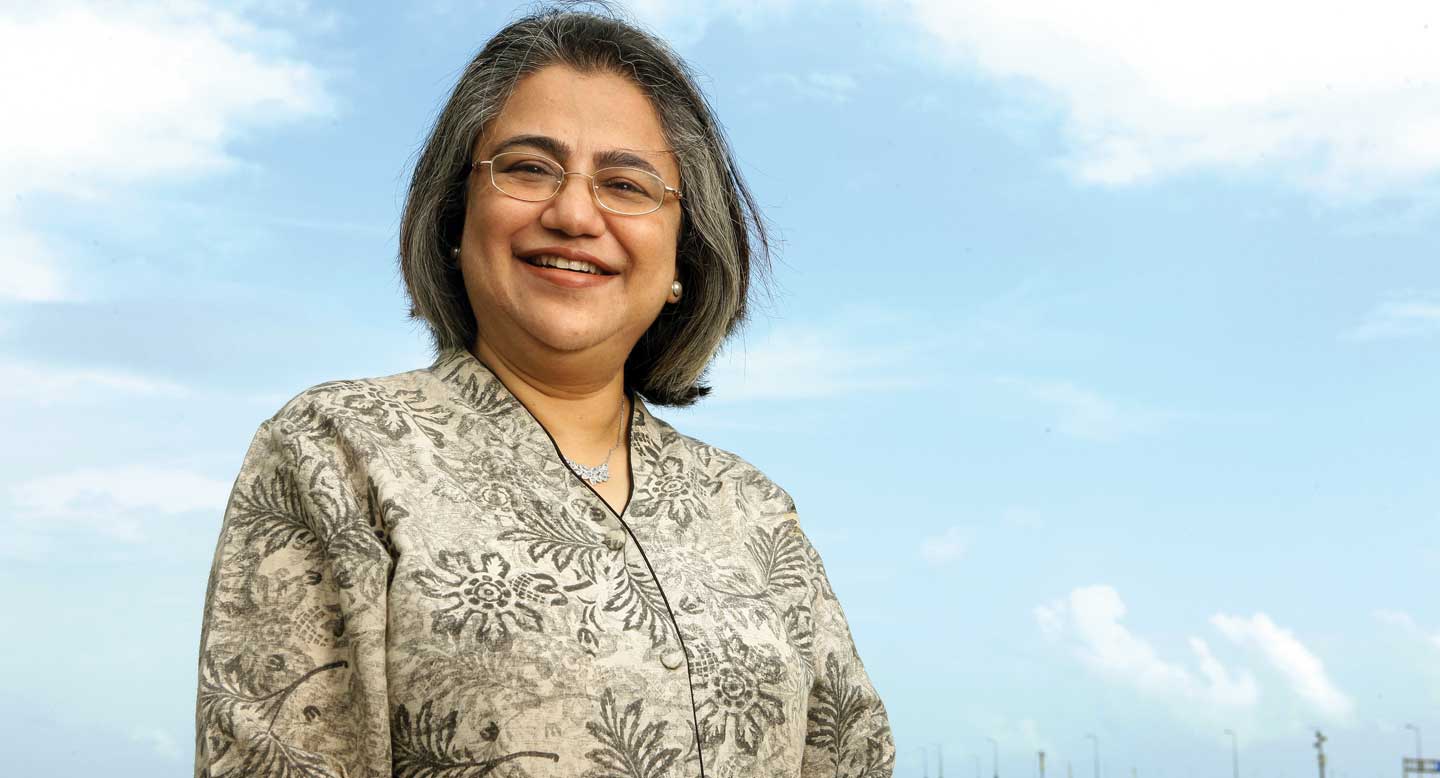Roopa Kudva nearly celebrated a silver jubilee at CRISIL before she assumed her role as the leader of impact investment firm, Omidyar Network India. At Omidyar, parallel efforts to invest in impact-driven ventures in both not-for-profit and for-profit companies is at the core of its investment philosophy.
In this chat with The Smart CEO, Roopa touches upon Omidyar’s strategy to pick and choose the right companies to bet on, alongside the factors that have contributed towards making her an impactful leader

Indus OS aims to connect the next one billion people in emerging markets through its multi-lingual, regional operating system that helps early users in India and other emerging markets take advantage of smartphones.
Scripbox, an online investment service platform, focuses on helping first-time investors in India save and invest to achieve their long-term financial goals. Through its educative approach and a combination of best of portfolio theory and behavioural finance, it has created an automated, yet simplified investing experience for consumers.
Akshara Foundation works with 14,000 schools in Karnataka to support mathematics and English learning and provides libraries inside schools.
A lot of the capital that goes into impact investing is foreign capital. However, availability of domestic capital for impact investing is expected to accelerate over the next five to 10 years from entrepreneurs and HNIs who understand the value of supporting such ventures.
![]()
These are companies that have created businesses based on innovation; businesses that seek to create social impact and grow the industries they operate in, namely consumer Internet and mobile, financial inclusion and education. While Indus OS and Scripbox have a social agenda alongside for-profit revenue growth, Akshara Foundation strictly operates on a non-profit basis and aims to cover more than one million students in Karnataka alone, over the next three years. The common ground that these companies share is that they are a part of the Omidyar Network India Advisor’s (Omidyar) portfolio and each aspires to create a social movement.
Evidently, India is emerging as a big hub for impact investing and social innovation with a lot of foreign money going into domestic ventures, especially those with a double bottom line. In fact, at present, there are about 50 impact investment funds in India that have invested nearly US $2.5 billion dollars in over 350 enterprises. According to the Impact Investors Council, social impact investment in India attracted US $500 million in 2015 and is expected to double to US $1 billion by 2020.
“It is India’s time now,” believes Roopa Kudva, partner at Omidyar Network and managing director of Omidyar Network India Advisors, an impact investment organisation that aims to advance social good at the pace and scale the world needs today. “Never before has the ecosystem for entrepreneurship been as strong as it is today, whether it is the kind of money available or the policies, supporting its growth,” elaborates Roopa. This apart, some of the best minds are turning to entrepreneurship, with almost 10 per cent of IIT graduates turning entrepreneurs.
The drivers of social impact investment include an increase in smartphone penetration in India, use of local languages on the Internet, opportunities based on Aadhaar cards, skills policies and experimentation in property rights.
“This just means that these are exciting times for our work ahead,” says Roopa. Hence, since the time she joined Omidyar in July 2015, she expanded its team by adding six new investment professionals and took the team size to 19. The company will continue to expand in India and open a second office in Bengaluru. Roopa also expects the capital deployed to increase significantly to US $300 million by 2020 from the current level of US $170 million.
In this story, Roopa Kudva takes us through her personal growth at Omidyar, the company’s investment theses, its approach to spotting portfolio companies and its future plans.
Exciting change of pace
Prior to joining Omidyar, Roopa spent 23 years of her career at CRISIL, interacting with leaders across 72 sectors, discussing an array of subjects. Yet, what excites her the most about her role at Omidyar is the type of people she meets on a regular basis. “We support entrepreneurs who have innovative ideas and are looking to leverage technology in new ways and achieve massive social impact at scale. Working with these young entrepreneurs, in both for-profit and not-for profit sectors is exciting, as they have big dreams and want to make a difference.”
Making her role even more interesting is the variety of thought-provoking conversations she often has with these entrepreneurs. “No two conversations with them are the same,” she adds. They vary from recruitment to fund raising strategies to a complete change in the business model. Citing an example, Roopa recalls, “There was an organisation which was doing classroom training and this model did not offer a potential for it to scale rapidly. It has now come up with a technology-based training module where a lot of learning can happen online or through the app and the need to go to the classroom is only 20 per cent of the course.”
Last year alone, we attracted US $500 million dollars and this number is expected to double by 2020. This data is from the impact investment council and the fact that we have an impact investment council itself indicates the kind of momentum the sector has seen.
![]()
Delving deeper into India
Roopa’s responsibilities for Omidyar India include managing its strategy, operations and development of its portfolio companies. “India is a very important geography for us and what we do in India is pretty much in line with our global strategy of populating two cheque books,” she explains. A non-profit organisation receives a grant and a for-profit company receives equity investment from Omidyar. Currently, it has invested about 70 per cent of funds in for-profit ventures while the remaining is distributed amongst the non-profits.
India is also one of the few geographies in which the company has a fully built up portfolio; it has spanned all five sectors (consumer Internet and mobile, education, financial inclusion, governance and citizen engagement and property rights) with investments in both profit and non-profit ventures. Omidyar invests at three distinct levels; affecting change in policy in the sector, creating sector infrastructure and supporting innovation from individual entrepreneurs. Roopa cites some examples from the company’s portfolio to explain this thought process. At the level of policy, Omidyar has invested in The Education Alliance, a company which works with the government, to get government schools to collaborate with private operators. As for creating sector level infrastructure, it has invested in Varthana that provides loans to affordable private school. At the entrepreneurial level, it has invested in Aspiring Minds, which tests a candidate’s employability skills using computerised methods and a standardised test.

Looking at the money trail
Pierre Omidyar, founder of eBay, created the Omidyar Network on the basic principle that the firm can make any kind of investment – a grant into non-profits or equity investment into for-profits – as long as there was sustainable social impact. Importantly, this is a patient capital. The organisation understands that if it is investing in truly innovative ideas with a goal of impacting change within a sector, then patience is the next best thing it can give its entrepreneurs, apart from capital. Accordingly, the company has a time horizon that is longer than most venture capital firms. On the non-profit side, the company does two cycles of grants for about three years each. “This long engagement with entrepreneurs enables us to support them in many other ways be it human capital, recruitment, leadership development, learning new techniques in product management and more,” states Roopa.
Making a global connect
Omidyar connects companies from its global portfolio to the Indian market. Roopa narrates the example of a global company called Lenddo that uses social media data to enable the new middle class in emerging markets to access affordable financial services. Omidyar introduced it to many banks in India and is trying to work together on some pilot projects. Lenddo is currently working in 19 countries all over the world including Latin American and other South-East Asian countries.
As far as an Indian company that is applicable in the global arena is concerned, Zimmber is a one-stop shop for handyman services in India, connecting consumers with myriad service providers from home cleaning to plumbers, painters, carpenters and electricians. “They enable blue collar workers to access customer in a much more efficient manner,” says Roopa, with the belief that the same model may be applicable in other global markets.
Investing the same dollar
Omidyar does not have separate teams working on its for-profit and non-profit ventures. “The same investment professionals work on both and they decide whether we should deploy grant dollars or equity dollars,” says Roopa. Omidyar has found that grants or non-profit money is more effective where it is a policy organisation or where markets do not function at all. “It is the absolute base of the pyramid,” says Roopa. For-profit equity is deployed where there is value being created, where you can scale a business rapidly.
The first screening for a company to fall under the Omidyar umbrella is a test of its sustainability and its application of innovation. Once this is determined, the other parameters such as analysis of the business, viability of the business and strength of the organisation is considered. The entrepreneurs are assessed on how passionate they are about what they do and how driven they are to accomplish what they set out to do. This apart, Omidyar focuses on the entrepreneur’s ability to attract talent and remain resilient. “In the early stages of a company, things rarely go according to plan. People have to reorient their strategy, and at times, even the core business model. The whole story of a startup is one of continuous setbacks and how resilient the entrepreneur is,” explains Roopa.
Talking specifically about the for-profit portfolio companies, Roopa states the importance of never losing sight of the bottom-line, “Just because an enterprise has a social impact, it does not mean it should give lower returns.” Of course, certain sectors yield higher returns and some, a lot lower and this is independent of the social mandate. “Once we determine that an organisation has a social impact, the organisation has to be sustainable and compete with others in the industry and provide higher returns or at least stay on par with the industry,” says Kudva.
The rapid penetration of Internet and the ability to offer whole range of services will open up many new opportunities. The way we learn, the way we work and travel, the way we consume has already started to change significantly and that change will accelerate in the years to come.
![]()
Judging sectoral impact
Considering the very nature of patient capital, the impact of Omidyar’s investment in India, can be gauged from the changes seen at the sectoral level. Roopa cites an example, “In education, we gauge our impact based on the improvement in the learning outcome for children.” In financial services, increasing access to more innovative products and services at lower costs is a good measure of impact. As far as consumer Internet and mobile is concerned, impact is evident through better access to utilitarian goods and services (transport, HC, access to services like plumbers, carpenters etc. ) on a large scale and at lower costs. The progress made in digitisation of land records and an increase in the number of people who have a title to their property in India serves as a measure of impact in the property rights initiative.
“Overall, we are a disciplined and thesis-based investor,” says Roopa. In each sector the company works in, it has a clear investment thesis like improving learning outcome in K-12 schools, improving workforce readiness, digitisation of land records and so on. Ten years from now, it hopes to make substantial progress with its portfolio companies achieving significant impact through scale.
Moreover, the company expects new themes to emerge, going forward. “Opportunities will increase, new areas will open up and we will be doing whatever is relevant to create social impact,” says Roopa. Omidyar has already invested in increasing team size and by the end of next year it hopes to add another half a dozen people to prepare it for the times ahead.
Looking at the bigger picture, the company wants to work with philanthropists and evangelise the concept of impact investment. In fact, this community in India is becoming a lot more strategic about their giving and wants to give more regularly to specific causes. “As people understand the concept of impact investing, we hope that in five to 10 years time, the pool of capital impact investment in India will get significantly higher,” concludes Roopa Kudva, on an optimistic note.

Roopa Kudva’s journey at CRISIL
At the very beginning: When I joined CRISIL in 1992, it was very much like a startup. The challenge then was evangelising a new concept in India; that of rating and bringing transparency to market operations. It was difficult because interest rates in India were controlled at this time. A couple of things helped us gain some ground:
- On par with the best – under the guidance of Pradip Shah, there was tremendous clarity that our analysis would meet global standards, even if it meant adopting analytical stances that were ahead of India
- Just be out there – we spoke at conferences, seminars, groups and more to spread the concept and generate awareness and acceptance of the idea
On to phase two: While CRISIL was started in the late 1980s, it was between 2005 and 2007 that dramatic expansion for ratings took place. Till then, we had rated only around 400 to 500 companies. In 2005 we started rating small and medium sized enterprises and companies for their bank borrowings and there was a dramatic increase in volume. By the time I left, we had rated around 13,000 to 14,000 companies for bank loan ratings and 55,000 companies in small and medium enterprises segment.
We had to make ratings affordable to the small enterprises and to make this happen we used different processes; technology, automation and rating subsidies from the government. This phase enabled funding access to many SMEs who were struggling to get funding from banks.
The learning in this phase of rapid expansion is that you have to leverage technology to scale up. Dependence on system and processes is much higher and knowledge management systems are crucial. Not just this, training of people assumes great importance.
Fearless scale up: Very early on, we realised that if our rating system had to be independent we had to have other sources of revenue so that we could take whatever rating action like a downgrade without being concerned about the commercial implication. We went through a phase when we downgraded a lot of our clients during the economic downturn and we lost a lot of clients to competition. That is when we decided to have other sources of revenue and go outside India. We started through a series of acquisitions – Irevna and Coalition. By the time I left CRISIL, the global business was larger than ratings.
This phase helped me understand what it takes to work in a global market with a sophisticated organisation. There were huge learnings in terms of quality, turnaround time, adapting to changing markets and a lot more. We saw the turmoil that struck clients after the global financial crisis in 2008 and we had to adapt as they were adapting.
In the public eye: In 1993, CRISIL decided to become a listed company. We were the first rating agency anywhere in the world to go public. Even as we were expanding the business, diversifying and growing the market in India, we were accountable to our shareholders. It brought in the discipline and made us much more conscious that we were answerable to so many different stakeholders like markets, regulators and shareholders.
From CRISIL to Omidyar
Core competencies retained:
- Basic skill sets – at CRISIL and at Omidyar, I need the basic skill set of business evaluation, financial analysis, management and entrepreneur evaluation.
- At CRISIL, the research business covered about 72 different industries and that knowledge and diversity helps me in my work at Omidyar.
- One always needs to communicate well with entrepreneurs, colleagues and the whole range of stakeholders.
- At CRISIL, the majority shareholder in the last 10 years of my stint there was S&P which was headquartered in New York. So I learnt working, communicating, navigating and collaborating across a global organisation which I find useful here. At Omidyar, I have colleagues and investee organisations from all over the world that we try to connect with each other. For example, we are trying to bring some of our investees in other markets to come and work in India.
Core competencies left behind:
- The big difference between CRISIL and Omidyar is the type of organisations that we are dealing with. At CRISIL, most of the entrepreneurs were established in their business, had grown their companies and had a track record on the basis of which you could evaluate them. At Omidyar, you are dealing with entrepreneurs who are at the early stage. This meant I had to make necessary adjustments to understand and evaluate them.
- Another big difference is the long-term nature of the work at Omidyar. We are organised in five sectors and we are trying to achieve change at a sectoral level. If you are looking at a company which is an early-stage startup, clearly, it will be a while before you see a big impact or outcome. This is very different from what I was used to at CRISIL where you have listed organisations, the routine of quarterly results, clients that you work with also work on projects which have a turnaround time of a year or less. Even if you are building a new product, you are looking at a maximum of two or three years as a time frame.
Social investment in numbers
50 impact investment funds invested US $2.5 billion dollars in 350 enterprises.
Impact investment in India was US $500 million in 2015; to reach US $1 billion by 2020
Capital deployed by Omidyar currently is US $170 million to increase to US $300 million by 2020
70 per cent of funds are for-profit ventures; 30 per cent is for non-profit ventures



